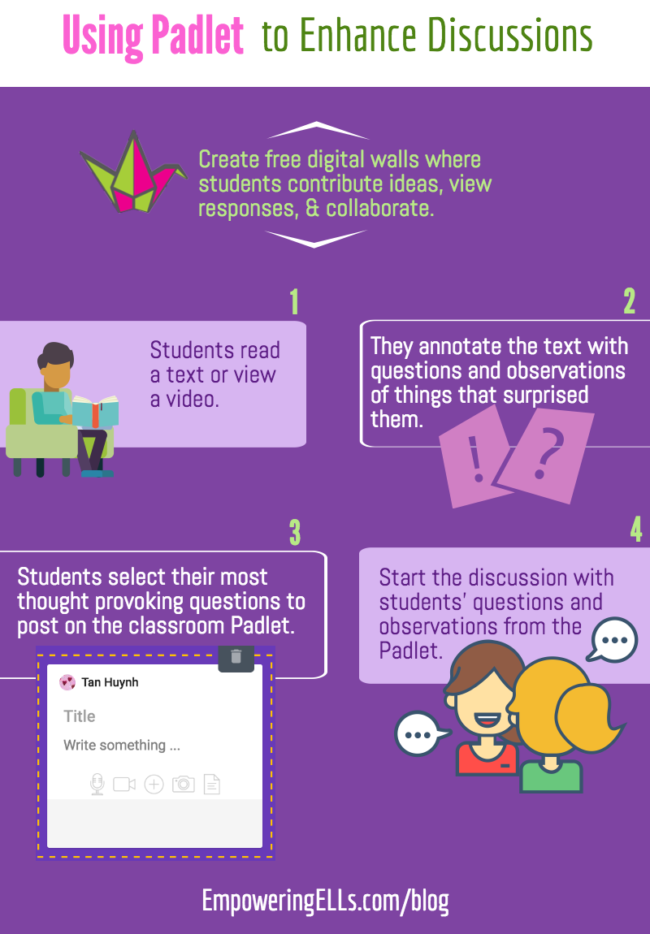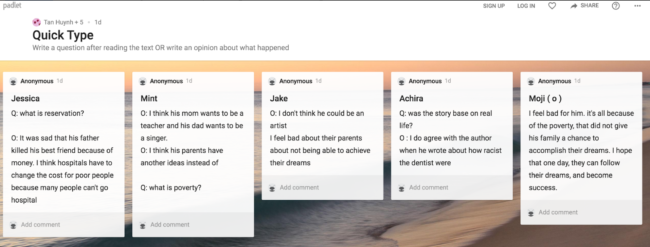This article on using Padlet to enhance discussions of texts is part 4 of Transforming Instruction Through Technology series.
 Few things can send an English teacher’s heart soaring like a lively student-led discussion of texts. However, I’ve seen many deflated discussions caused by teachers who lob question after question to guide students to think and discuss. What’s wrong with that, you ask?
Few things can send an English teacher’s heart soaring like a lively student-led discussion of texts. However, I’ve seen many deflated discussions caused by teachers who lob question after question to guide students to think and discuss. What’s wrong with that, you ask?
This teacher-centered approach corrals students to guess the teacher’s thinking. However, the volleying of ideas about texts needs to be between students and promoted by their questions and observations.
Collecting Questions with Padlet
Student Annotation
In the previous post, I described how my ELs are taught to annotate a text using Google Docs. Annotating strengthens the interactions between the text and the ELs, which cultivates comprehension. It reminds students to stop and think about the text.
They pause to write a brief note about what they read, and many choose to write a question or make an observation of something that surprised them. I emphasize that the questions have to be ones they don’t know the answers to.
When students come to class, I have them evaluate which questions they most want to explore. Students post these juicy questions, often more inferential in nature, on our classroom Padlet.
Discovering Padlet
Padlet is a free online program that allows people to post ideas on digital sticky notes, view each other’s ideas on one site, and comment on the notes. It’s similar to physical sticky notes, but with improved functionality, such as the ability to:
- add pictures
- link to other sites, and
- add a voice recording.
Below is an example of a Padlet my 7th graders used to discuss Sherman Alexie’s The Absolutely True Diary of a Part-time Indian.
Once students have finished placing their questions and observations on the Padlet, I have them read the all the notes. Then we come together to have a Harkness discussion about the text using these notes. I ask, “Which Padlet notes do you want to start with?” Sometimes, the questions I was going to ask were asked by the students.
Student-Led Discussions
Here’s the part everyone forgets: the students answer each other’s questions. They are the ones responsible for providing responses (not me) because a student-led discussion is a collaborative process of constructing meaning between students and assisted by the teacher.
By having ELs seek the answers from each other, we move away from the sage on the stage approach and lean towards a one that’s more like – the guide on the side. This change in strategy shifts a classroom discussion from being a teacher-student exchange to a student-student construction of meaning.
Show Students the Parallel to Social Media
Modern learning requires that students interact with the text and with other readers by asking questions and answering each other’s questions. They do this naturally on social media by posting comments to a video on Youtube or an image on Instagram. We simply take this practice and transfer it to reading a text in school.
The Teacher’s Role
Does using Padlet to enhance discussions of text mean that you can go grade papers while the ELs are discussing?
No!
I actually join students by adding questions to the Padlet. However, they often don’t pick my Padlet questions because they’re more interested in answering each other’s questions. But I’m fine with that because picking the questions they want to be answered will make them attentive listeners.
If all of their questions are answered in the time allotted, then I have them discuss my Padlet question.
The teacher’s role was largely completed when we designed this Harkness discussion itself using Padlet. We offered a way for students to interact with the text, share their thinking, and construct meaning together. Instead of analyzing texts for ELs, we offer ways for students talk about texts.
We need to let go, and let students build.Takeaways
EL instruction experts Andrea Honigsfeld, Heather Parris, and Lisa Estrada write that “A technology-rich learning environment provides the opportunity to deliver lessons that allow for the precious time in class to be spent completing hands-on activities and using English in an authentic and meaningful manner” (2016, Kindle locations 4-6).
Technology needs to serve learning rather than being the centerpiece. Tech provides ELs with a purpose to use language authentically. Using Padlet this way primed students for a discussion about the text, which is the real goal.
Tech is like a highway, but highways are never destinations . Padlet was only the means to the end; it was never the point itself.
Parris, H; Estrada, L; Honigsfeld, A. ELL Frontiers: Using Technology to Enhance Instruction for English Learners (Kindle Locations 4-6). SAGE Publications. Kindle Edition.


